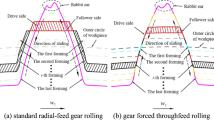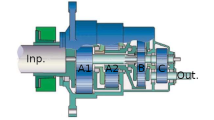Abstract
This paper presents an investigation to find out how lubrication parameters affect lubrication characteristics of gear transmission systems for the purpose to acquire enhanced lubrication performance for such systems through design optimization. A novel high precision roller enveloping reducer is selected, and effects of key parameters on its lubrication performance were thoroughly studied. The key parameters include oil viscosity, immersion depth, rotation speed of the worm gear, worm arrangement, and volume of oil recess. Taguchi method was then applied to optimize those parameters to achieve an enhanced lubrication performance in the roller enveloping reducer. The research approach employed for this study can be described as follows: at first, a numerical simulation study was performed and simulation results were validated using experimental data; next, design domains for the key parameters were created over a wide range of values, and the design of experiments (DOE) method was applied to determine how the parametric values affect the lubrication characteristics via numerical calculations; afterwards, analysis of variance (ANOVA) was performed to determine the parametric values that would lead to the optimal lubrication performance. Our results showed that the novel roller enveloping reducer can provide desirable lubrication and meshing performance by applying the optimal parametric values. In our study, the lubrication performance is indicated in terms of churning losses and number of lubrication particles. Effects of the key parameter on them are discussed in this paper. This study presents a design method for screening the optimal parameters for best lubrication performance of gear systems. The employed research approach can be applied for lubrication design of other transmission systems.















Similar content being viewed by others
References
Chan C-C, Hsu W-C, Chang C-C, Hsu C-S (2010) Preparation and characterization of gasochromic Pt/WO3 hydrogen sensor by using the Taguchi design method. Sensors Actuators B Chem 145(2):691–697
Concli F, Gorla C (2016) Numerical modeling of the power losses in geared transmissions: Windage, churning and cavitation simulations with a new integrated approach that drastically reduces the computational effort. Tribol Int 103:58–68
Concli F, Gorla C (2017a) Numerical modeling of the churning power losses in planetary gearboxes: an innovative partitioning-based meshing methodology for the application of a computational effort reduction strategy to complex gearbox configurations. Lubr Sci 29(7):455–474
Concli F and Gorla C, CFD simulation of power losses and lubricant flow gearboxes, Technical Paper, American Gear Manufactures Association Fall Technical Meeting, 2017b, 2–14
Concli F, Gorla C, Torre AD, Montenegro G (2014) Windage power losses of ordinary gears: different CFD approaches aimed to the reduction of the computational effort. Lubricants 2(4):162–176
Concli F, Torre AD, Gorla C, Montenegro G (2016) A new integrated approach for the prediction of the load independent power losses of gears: development of a mesh-handling algorithm to reduce the CFD simulation time. Advances in Tribology 2957151 (8 pages)
Concli F, Maccioni L, Gorla C (2019) Lubrication of gearboxes: CFD analysis of a cycloidal gear set. WIT Trans Eng Sci 123:101–112
Deng X-Q, Potula S, Grewal H, Solanki KN, Tschopp MA, Horstemeyer MF (2013) Finite element analysis of occupant head injuries: parametric effects of the side curtain airbag deployment interaction with a dummy head in a side impact crash. Accid Anal Prev 55:232–241
Deng X.-Q, Wang J, Wang S.-K, Wang S.-S, Liu Y.-C, and He G, Meshing characteristics and engagement of anti-backlash single- and double-roller enveloping hourglass worm gear, IMECE2019–11332, Proceedings of ASME 2019 International mechanical engineering congress & exposition, Salt Lake City, UT, USA, November 11–14, 2019a
Deng X-Q, Wang J, Wang S-K, Wang S-S, Wang J-G, Li S-C, Liu Y-C, He G (2019b) Investigation on the backlash of roller enveloping hourglass worm gear: theoretical analysis and experiment. ASME J Mech Design 141(5):053302
Deng X.-Q, Liu Y.-C, and He G., Design and assessment of an antibacklash single roller enveloping hourglass worm gear, SAE Technical Paper 2019-01-1071, Proceedings of SAE 2019 World congress experience, Detroit, MI, USA, April 9–11, 2019c
Deng X-Q, Wang J, Wang S-K, Wang S-S, Liu Y-C, He G (2020a) A comparison study of anti-backlash single- and double-roller enveloping hourglass worm gear. Chinese J Mech Eng 56(3):88–95
Deng X-Q, Wang S-S, Hammi Y, Qian L-M, Liu Y-C (2020b) A combined experimental and computational study of lubrication mechanism of high precision reducer adopting gears meshing with complicated space surface contact. Tribol Int 146:106261
Deng X-Q, Wang J, Wang S-K, S.-S, Liu Y-C, He G (2020c) An optimal process of machining complex surfaces of anti-backlash roller enveloping hourglass worms. J Manuf Process 49:472–480
Deng X.-Q, Wang S.-S, Wang S.-K., Wang J, Liu Y.-C, Dou Y.-Q, and He G (2020d) Lubrication mechanism in gearbox of high-speed railway trains, Journal of Advanced Mechanical Design, Systems, and Manufacturing (Machine Design & Tribology), 14(4)
Dou Y-Q, Ricks TM, DuBien JL, Lacy TE, Liu Y-C (2017) Response surface modeling to facilitate the parametric study of transversely impacted pressurized pipelines. Thin-Walled Struct 119:647–653
Groenenboom PHL, Mettichi MZ, and Gargouri Y, Simulating oil flow for gearbox lubrication using smoothed particle hydrodynamics, Proceedings of International Conferences on Gears, 2015, Garching, Germany
Ji Z, Stanic M, Hartono EA, Chernoray V (2018) Numerical simulations of oil flow inside a gearbox by smoothed particle hydrodynamics (SPH) method. Tribol Int 127:47–58
Laruelle S, Fossier C, Changenet C, Ville F, Koechlin S (2017) Experimental investigations and analysis on churning losses of splash lubricated spiral bevel gears. Mechanics & Industry 412(18):1–9
Liu Y-C (2010) Thin-walled curved hexagonal beams in crashes—FEA and design. Int J Crashworthiness 15(2):151–159
Mandol S, Bhattacharjee D, Dan PK (2016) Robust optimization in determining failure criteria of a planetary gear assembly considering fatigue condition. Struct Multidiscip Optim 53:291–302
Menon M, Szewc K, and Maurya V, Multi-phased gearbox modeling using GPA-accelerated smoothed particle hydrodynamics method, Proceedings of ASME-JSME-KSME 2019 8th Joint Fluids Engineering Conference, 2019, San Francisco, CA, USA
Montgomery DC (2009) Design and analysis of experiments. John Wiley & Sons, Inc.
Qi Z-C, Wang X-X, Chen W-L (2019) A new forming method of straight bevel gear using a specific die with a flash. Int J Adv Manuf Technol 100:3167–3183
Renjith S, Srinivasa VK, Shome B (2015) CFD based prediction of spin power loss of automotive differential system. SAE Int J Commer Veh 8(2):460–466
Taguchi G, Konishi S (1987) Taguchi methods: orthogonal arrays and linear graphs—tools for quality engineering. American Supplier Institute Press, Allen Park
Funding
This work was supported by the National Natural Science Foundation of China under grant no. 51875479 and the Sichuan Distinguished Youth Fund under grant no. 19JCQN.
Author information
Authors and Affiliations
Corresponding author
Ethics declarations
Conflict of interest
The authors declare that they have no conflict of interest.
Replication of results
The authors declare that all results presented in this work are replicable. Computer models, original experimental data, and other nonconfidential data relevant to the present study are available upon request.
Additional information
Editorial Responsibility: Axel Schumacher
Rights and permissions
About this article
Cite this article
Deng, X., Wang, S., Youssef, H. et al. Study on the influence of key design parameters on lubrication characteristics of a novel gear system applying Taguchi method. Struct Multidisc Optim 62, 2833–2847 (2020). https://doi.org/10.1007/s00158-020-02640-1
Received:
Revised:
Accepted:
Published:
Issue Date:
DOI: https://doi.org/10.1007/s00158-020-02640-1




